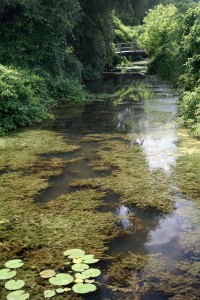A highly invasive aquatic species, known as Hydrilla verticillata, has made its way into the Cayuga Inlet, posing a potential threat to Cayuga Lake if untreated.

Hydrilla is a dense, fast-growing perennial that can thrive in almost any freshwater environment, and this is the first time it has been found in upstate New York waters. It can grow anywhere, from a few inches of water up to a reported 30 feet. If unchecked, it can completely dominate the environment it inhabits, creating a mono-culture that would crowd out native plant and insect species.
Roxy Johnston, watershed coordinator for the City of Ithaca, said the city is asking boaters to voluntarily stop boating and leave their boats docked in the inlet until the herbicide has been administered.
The Cayuga Inlet Hydrilla Task Force was formed in August to deal with the infestation and keep the public informed, but they have faced some issues.
“It’s been a real struggle,” Johnston said. “This is the first time in the city we’ve encountered anything quite like this, and it turns out in a lot of ways, it’s the first time the state’s encountered anything like it. We’ve found out, a little bit to our dismay that most of us don’t have a lot of enforcement or regulatory powers regarding this.”
Holly Menninger, coordinator and senior extension associate of the
New York Invasive Species Research Institute, said Hydrilla is one of the worst aquatic plant invaders.
“It spreads really easily by its own volition in the sense that in a few weeks here, it’s going to make these tiny little buds that are going to disperse in the waterway,” she said. “But also as a result of human activities, particularly boating because the plant breaks apart really easily.”
Robert Johnson, an aquatic biologist on the task force, said the main concern is that this plant, if untreated, could spread to the Finger Lakes and further.
“All we need to have is a fragment, a tiny tiny piece of that, and it will send out roots and start growing,” he said. “We really want to get it confined and get a handle on this before it gets too widespread.”
Johnson said the task force is trying to get a handle on the Hydrilla before the winter to prevent it from spreading further. He said the plant has already produced tubers like “little potatoes underground,” which will survive for six to 10 years. However, it is possible, he said, to get a handle on the turions, which in October will bud and spread.
Menninger said the plant could cause not only ecological problems for native species, but also could have economic consequences.
“Particularly for Ithaca, the Cayuga Inlet is a great source of revenue. It’s important to the economy because there’s a lot of restaurants and recreation-based businesses that are there,” she said. “If we don’t do something, it will be almost impossible to move boats, whether those are motorized or non-motorized.”
Menninger said to prevent the Hydrilla’s turions from multiplying, the task force has decided to use an herbacide and is waiting for approval from the Department of Environmental Conservation to do so.
According to a task force document, it will cost an estimated $62,350 to apply the herbacide to the entire Inlet.
“Given the time of year,” Menninger said. “Our goal with using the herbacide is to kill all the green part of the plan now, and basically stop the plant in place.”
She said hopefully by killing all the green parts of the plant, it will buy them time to pull together more resources.
Becky Robinson, coach of the women’s crew team, which practices and docks its boats by the Inlet, said she noticed the Hydrilla at the end of summer.
Robinson said she supports treatment of the Hydrilla, and the team will continue to practice until the herbacide is applied.
“As long as we follow safe boating practices, as in wiping down and cleaning the boats when we come in, not rolling through the Hydrilla, as they put it ‘we can’t keep you off,’” she said. “They’re asking boaters not to boat, but at the same time, until they actually pass it, there’s no law saying people can’t boat.”
Menninger said she hopes that since Hydrilla was caught in the Cayuga Inlet so soon, it can be taken care of.
“We caught it early and we have a real opportunity to act,” she said. “So we need to act fast.”







